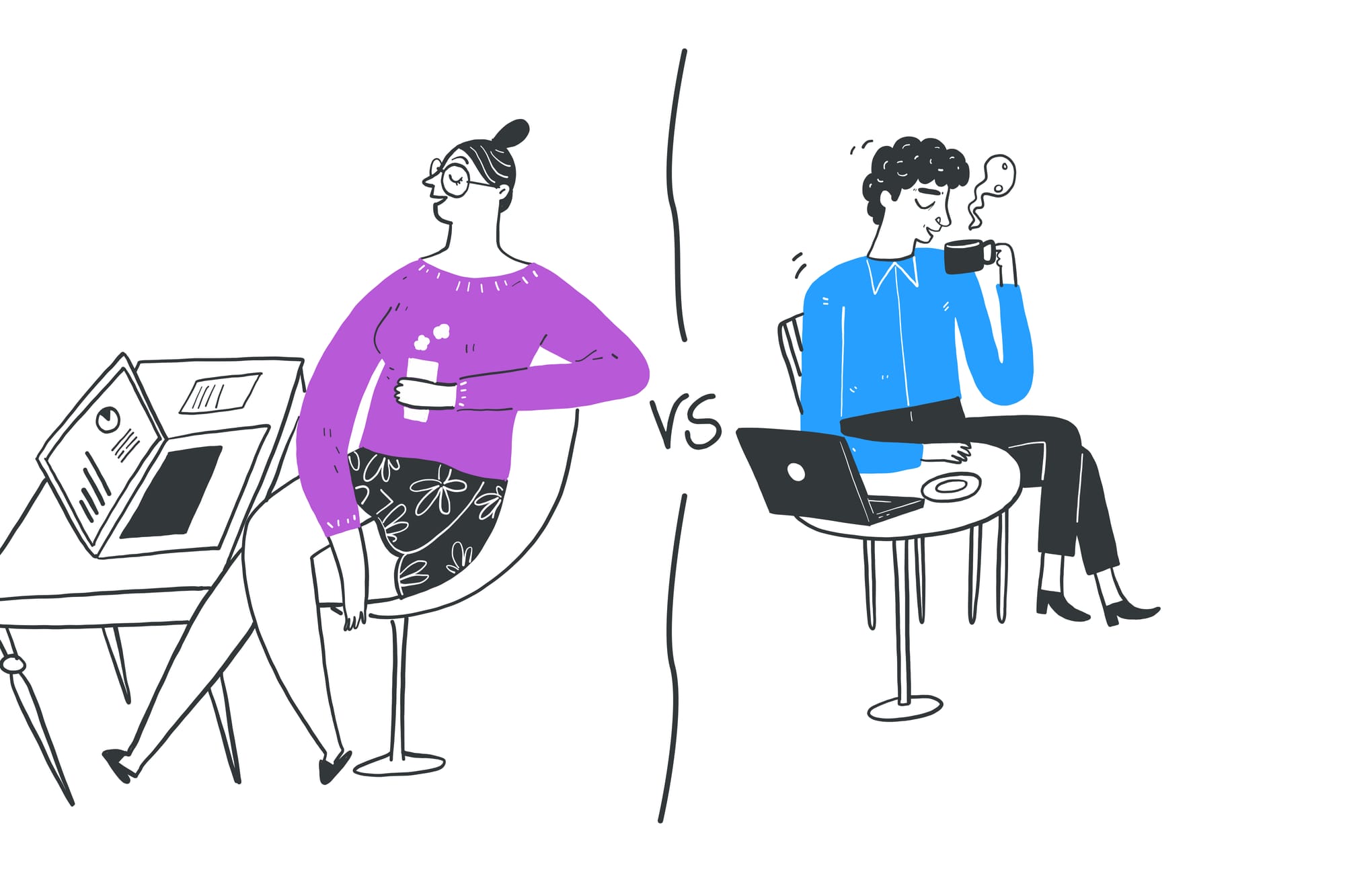As a team leader or manager, understanding the nuances of workplace conflict resolution is vital. Efficiently addressing and resolving disagreements or disputes within your team is the key to maintaining harmony and productivity.
With a conflict resolution strategy, you’ll be ready to deal with conflicts in the workplace as they happen. If they’re left ignored, they can decrease productivity, strain relationships, increase stress, and have a negative impact on your team’s morale.
In this guide, we’ll delve deep into the strategies of conflict resolution and share insights to ensure your workplace remains a haven of collaboration and mutual respect. 🧘
What Is Conflict Resolution?
Jean-Paul Sartre famously said that hell is other people. Although slightly out of context, this sentiment can sometimes ring true, especially in a professional environment. But what exactly is conflict resolution?
At its core, conflict resolution refers to the methodological approach where two or more parties with disagreements find a peaceful solution to their differences. It's a skill, an art, and when done correctly, a business boon.
In my twenty-something years of experience as a manager, I’ve learned that resolving conflicts is an essential leadership skill to have. Those who resolve conflicts at a managerial level usually do so by showing compassion, respecting diverse opinions, and achieving consensus. By setting aside personal differences, great managers can achieve a conducive work environment that promotes collaboration and productivity. It’s a win-win-win: for direct reports, for the manager, and for the company!
Where Does Workplace Conflict Come From?
Once there was a huge conflict at my workplace between a senior engineer and the CTO. Right before the confrontation happened, I had that sick-to-your-stomach feeling because I knew a tense situation was bubbling under the surface. The conflict eventually spilled out of the cafeteria and affected all of the developers. A palpably tense work environment was felt for the rest of the week, and it killed productivity and caused team morale to drop. We almost didn’t get the feature we were building delivered to our client.
To address conflicts effectively, understanding the origin is crucial. Typical reasons for disagreements in a professional environment include:
- Differences in perspectives, values, and objectives
- Communication barriers leading to misunderstandings
- Misinterpretations of intentions
- Differing work styles and expectations
- Power struggles and competition for resources
- Organizational changes and instability
- Personal factors like ego and emotions
- Ineffective leadership and lack of clarity in roles
- Inadequate conflict resolution processes
- External factors like market pressures and client demands
The Benefits of Conflict Resolution
You don’t want to let problems fester to the point that they can destroy your company. But you also have to acknowledge that resolving workplace conflict isn’t easy. You’re often trapped in the middle of something, and in most cases, you don’t know how to even begin the process of fostering harmony and peace between conflicting parties.
But by addressing conflicts head-on and finding resolutions right away, you can unlock tons of benefits.
Resolving conflicts quickly:
- Fosters better communication and understanding among individuals or groups
- Promotes collaboration and teamwork
- Enhances problem-solving and decision-making skills
- Reduces tension and negative emotions in the workplace
- Builds stronger relationships and trust
- Increases productivity and efficiency
- Minimizes disruptions and conflicts that can hinder progress
- Improves morale and creates a positive work environment
- Encourages creativity and innovation
- Enhance overall organizational effectiveness and success
The Top 6 Conflict Resolution Strategies
There are several conflict resolution strategies that individuals often use to manage conflicts. I wouldn’t say that all of them work well, but that really depends on the person, the situation, and how much they’re willing to put up with the conflict.
Here are the most common strategies:
Avoidance
Avoidance is when individuals sidestep the conflict by ignoring its resolution. If the conflict is avoided temporarily, it might be okay to let cool heads prevail before finding a solution. But if the problem is avoided permanently it can lead to some serious downsides.
When we sweep problems under the rug, they tend to fester and get worse over time. It creates an uncomfortable atmosphere where tension builds up (see the above anecdote), and people become disengaged or resentful.
Plus, avoiding problems means we miss out on opportunities for growth and improvement. Didn’t the Dalai Lama say that? 😂 By addressing issues head-on, we can foster better communication, build stronger relationships, and create a more positive and productive work environment.
Mediation
Mediation is a powerful strategy for resolving workplace conflicts that puts people right at ground zero. It brings in a neutral third party, the mediator, who acts as a “referee.”
The mediator creates a safe, neutral space where everyone involved can openly express their feelings, concerns, and perspectives. Mediators listen attentively, show empathy, and help foster understanding between the conflicting parties.
Through this collaborative process, mediation aims to find win-win solutions that address the underlying issues while preserving relationships. It's all about encouraging open communication, promoting empathy, and finding creative ways to resolve conflicts.
If you take this route, you’ll empower your direct reports to take ownership of the resolution process and pave the way for a more harmonious and productive work environment.
Competition
Competition is an approach to resolving workplace conflicts, although it may not always be the most ideal or effective method. In a competitive strategy, conflicting parties engage in a win-lose mindset, each striving to assert their own interests and emerge as the ‘winner.’
While competition can sometimes lead to quick decisions, it often sacrifices collaboration. The people involved are often left with bitter tastes in their mouths, as the conflict may manifest in other ways and create a hostile environment. This is bad for long-term cooperation.
It’s important to remember that conflicts in the workplace are better approached with a focus on understanding, empathy, and finding mutually beneficial solutions.
Accommodation
Accommodation emphasizes cooperation. This strategy is used when one party in the conflict extends an olive branch for the sake of maintaining harmony and preserving good relations.
In the workplace, accommodation can be seen as an act of empathy and understanding, where individuals put aside their own desires or interests to accommodate the needs of their colleagues or team.
While accommodation can contribute to a positive and supportive work environment, it is important to strike a balance and ensure that your own needs are not consistently compromised.
By practicing accommodation with respect and consideration for others, individuals can foster mutual support, collaboration, and trust, leading to increased productivity and a stronger sense of unity among team members.
Collaboration
Collaboration, in my opinion, is the best and most powerful strategy for resolving workplace conflicts.
When individuals in a conflict adopt a collaborative approach, they find common ground and work together to find a solution. This strategy involves listening to different perspectives, expressing concerns and needs in a constructive manner, and engaging in problem-solving discussions that aim to address the issue at hand.
Collaboration promotes a sense of ownership and accountability among team members, as everyone has a voice in shaping the outcome.
By fostering a culture of collaboration, organizations can tap into the diverse skills and experiences of their employees, build stronger relationships, and achieve resolutions that not only address immediate conflicts but also contribute to long-term growth and success.
Compromise
Compromise requires a willingness to negotiate and make concessions in order to meet each other's needs and interests. Compromise acknowledges that not all demands or desires can be fully met, but seeks to find a balanced outcome that minimizes conflict and promotes cooperation.
This strategy encourages open communication, active listening, and a focus on finding common ground. It recognizes that maintaining positive working relationships and fostering a harmonious work environment is crucial for the overall success of the team.
By employing the compromise strategy, individuals can demonstrate flexibility, empathy, and a commitment to finding win-win solutions that address the core issues at hand while respecting the perspectives and concerns of all involved parties.
The 5 Steps to Conflict Resolution at the Workplace
Acknowledge and identify the conflict
Because conflict brings out the worst in people many prefer to stick their heads in the sand and hope that it will go away. Don’t do that. As a manager, it’s important to proactively address the conflict head-on to prevent potentially volatile situations in the future. By promptly addressing the conflicts, you can mitigate their negative impact and not worry about damage control that unsettled disputes may cause.
Define the problem at the root of the conflict
When confronted with a conflict between team members, it's important to do your due diligence and start gathering information. Take the time to have one-on-one meetings with each person involved to get a clear understanding of their perspectives on the issue.
Emphasize your role as an unbiased mediator, creating a safe space for open communication and sharing sensitive information. By doing this, you can also facilitate productive dialogue and work towards a mutually agreeable resolution.
Bring conflicting parties together
After meeting individually with all the people involved in the conflict, it's time to bring them together in a neutral meeting place to address their differences. This collaborative session should encourage brainstorming, active listening, and a willingness to embrace diverse viewpoints.
The goal here is to foster a shared understanding of the problem, clarify each person's role in the conflict, and explore potential solutions. It’s important for the parties involved to be cool and collected and not let things get out of control.
By promoting open dialogue and constructive engagement, you can start thinking about resolving the conflict and reaching mutually beneficial outcomes.
Find a solution
Once everyone has expressed their side of the conflict, the next step is to identify a satisfactory resolution and develop a plan to achieve it. Ideally, open dialogue and mutual understanding can lead to a natural resolution. However, if further intervention is needed, you have to walk them through the negotiation process to help them find common ground.
The contribution on your part may require time and effort as it involves setting aside your opinions, personal differences, and preferences to reach a compromise. So what’s the CTA? Collaborate with the individuals involved to establish a concrete action plan that outlines the necessary steps to achieve the desired solution.
By facilitating this process and ensuring effective communication, you can navigate the path toward resolving the conflict and promoting a positive outcome for all parties involved.
Follow up on the conflict in one-on-one meetings
Resolving a conflict is not the end. It actually requires ongoing vigilance and proper follow-up. As a manager, it's important to regularly touch base with the people involved to make sure that the resolution is working. If it’s not, time to get back to the drawing board.
Also, while everything may appear fine on the surface, it's crucial to take a step back and observe the situation to see if things are still tense. If it becomes clear that the solution is not working or needs tweaks, be proactive in collaborating with the people involved to reassess and explore other approaches.
Must-Read Books On Conflict Resolution
For those who wish to dive deeper into the intricacies of conflict resolution and management, here's a list of seminal books on the topic:
The Anatomy of Peace: Resolving the Heart of Conflict by The Arbinger Institute
Getting to Yes: Negotiating Agreement Without Giving In by Roger Fisher, William L. Ury, and Bruce Patton
Conflict Resolution Playbook: Practical Communication Skills for Preventing, Managing, and Resolving Conflict by Jeremy Pollack
The Mediator’s Handbook by Dr. Jennifer E. Beer PhD, Caroline C. Packard JD et al.
Getting to Zero: How to Work Through Conflict in Your High-Stakes Relationships by Jayson Gaddis
Never Split the Difference: Negotiating As If Your Life Depended On It by Chris Voss and Tahl Raz.
Conclusion
Workplace conflict is an inevitable part of professional life. But if you come equipped with an effective conflict resolution strategy, then you’ll be able to de-escalate conflicts that erupt in the workplace. It’s not a superpower at all to be good at conflict resolution; it’s just something you need to practice through boss ceremonies or workshops.
And when you get really good at it, you’ll be able to maintain harmony, foster better productivity, and encourage collaboration among team members.
SAMPLE DIALOGUE: How to Manage and Resolve Conflict in the Workplace the Right Way!
Mediator (Josephine): Good morning! So, David and Micaela, I appreciate your willingness to sit down and discuss this. I’m happy that we could create an open and safe space for both of you to express your views and concerns. Just for the record, I met with both of you individually a few days ago to hear the issue from your own perspective. Micaela, would you like to please share your frustrations once more so we could agree on the root of the problem?
Micaela: Thanks, Josie. Ok, David, I just wanted to say: I like you and respect you a lot, but I have to be honest - I feel really frustrated when you constantly dismiss my ideas during team meetings. It seems like you never take my input seriously, and it's starting to demoralize me.
Josephine: Thanks, Micaela. David. Thoughts?
David: Thank you, Micaela, and thank you Josie for being here to help us through this. Micaela, I don’t believe that I dismiss your ideas. You know I appreciate your work a lot. I tell you this quite often. The problem is that you're always pushing your agenda without considering other perspectives and looking at the problem from other angles. It's hard to have a productive conversation when you're so stubborn, interrupt the meeting, and insist on your solution being the only solution. We have resources, we have budgets, and we need to consider the problem holistically.
Josephine: It seems like there are differing perceptions here. Micaela, can you be more specific and elaborate on an instance where you felt dismissed?
Micaela: Sure. Just last week, during the strategy discussion on how the dashboard will look like for Venus, I presented an idea - which was a good idea; it got consensus from the others - but you immediately shut it down without giving it proper consideration. It made me feel undervalued and discouraged from contributing.
David: Micaela, maybe if you presented a more well-thought-out idea instead of rushing through it, I'd take them more seriously. I need substance, not just quick suggestions and whatever comes to mind right away. Let it come to mind, sure, but really reflect on the idea, and draw on your experiences and knowledge to see if it will really work.
Josephine: Thank you both for sharing your perspectives. It's evident that there's a disconnect in how you perceive each other's contributions. Now, let's focus on finding a solution that addresses these concerns and promotes collaboration.
Micaela: I’m all for collaboration.
Josephine: Great! So, how about we establish a process where everyone gets an equal chance to present their ideas, and they are evaluated based on their merits rather than personal biases? David?
David: I agree with the process, but I assure you there was no bias. But yes, let’s do that. We can implement a structured format for our meetings where each person gets dedicated time to present their ideas, like a pitch, with, of course, evidence to back up their ideas. Following this will be a constructive discussion without interruptions and - with no bias.
Josephine: Micaela, Is that okay with you?
Micaela: Yes, it definitely will help. It would make me feel more valued and give me confidence in sharing my ideas. I just want to be clear - I really like working here and I feel I could contribute a lot, I just want my ideas to be considered.
Josephine: Ok, let’s work on that starting today. Also, let's document these agreed-upon changes and share them with the rest of the team. Remember, conflict is natural, but resolving it respectfully is crucial for maintaining a healthy work environment. Also, let’s meet up in a few weeks, very quickly, to see if we made progress. Is there anything else either of you would like to add?
Micaela: Thank you, Josie, for helping us address this problem. I'm hopeful that these changes will improve our collaboration.
David: Agreed. Thanks, Josie, for guiding us through this conversation. I understand now how my behavior may have been perceived, and I'm committed to making positive changes.
Josephine: You're both welcome. It takes courage to address conflicts head-on, and I commend you for that. Moving forward: let’s keep the lines of communication open and continue working towards a more harmonious work environment. Let’s follow up soon. Have a great day!





